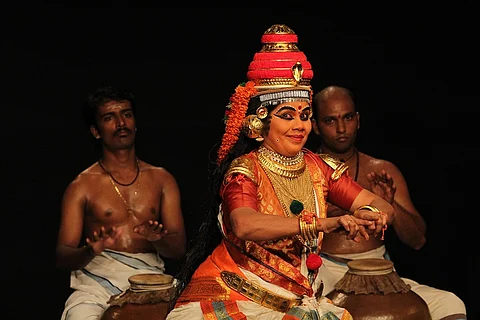Breaking through Koodiyattam’s caste-barriers: Kalamandalam Girija’s revolutionary journey
At Delhi’s Sangeet Natak Akademi theatre, 59-year-old Kalamandalam Girija is playing the role of Shauraseni, the mother of Kamsa, as a young girl frolicking at a river. Within minutes she transforms into the demoniac Dramila, a drunk, and then again, before the astonished eyes of her audiences, the voluptuous maiden.
Girija’s art is subtle and dramatic at the same time. But she is a pioneer as well: she broke the caste barrier to master it way back in the 70s – the first woman from a non-nangiar family to master koodiyattam. Only nangiar women and chakyar men were traditionally allowed into the art.
In Kerala, over the last few years, she has been spearheading a whole lot of creative experiments and attempts at reviving old, extinct pieces of work in the koodiyattam repertoire. These included rare works like Ozhukum Nangiyar and Parrakumkoothu, both needing acts of physical skill and sophisticated stagecraft.
“The more I am questioned and criticised the more energy I find to work with unusual pieces,” she says with a laugh. “To all the rigid, conservative people who asked me all those years ago ‘Why are you bothering with what you don’t own’ my answer is this, this is why I did it,” she says pointing to the stage.
To understand Girija’s triumph as an actor, it is important to step back in time – to 1971, in fact. The Sanskrit theatre tradition, with roots going back 2,000 years, had come out of temples 20 years before but it was still in the grasp of the chakyar and nangyar communities. Among men, Sivan Namboodiri had managed to break the barriers and learn koodiyattam but women from non-nangyar castes were still to defy the caste convention.
Girija was a school-going 13-year-old from a Moosad family, only somewhat familiar with the epics and Sanskrit. It was happenstance that the legendary guru Paimkulam Rama Chakyar was looking for a female student at Kalamandalam. Having set up the koodiyattam department at the institute he was having trouble finding female students.
“We lived next doors to Kalamandalam and he once asked my father if I would be interested. Like a puppet I walked into the class, no idea of what I was signing up for. I didn’t know I was setting a historic precedent,” she recalls.
Paimkulam Rama Chakyar was by then a veteran rebel – he had brought koodiyattam out of temples in 1957 and into totally secular spaces for common audiences. He introduced it in Kalamandalam in 1965 and went on to teach a non-chakyar, Sivan Namboodiri. In 1981, he was also to become the first chakyar to cross the seas and break a big taboo, to perform abroad. He remained impervious to the frowns that followed Girija’s induction into koodiyattam.
The 60s and 70s were a time of radical change in the tradition. The master was still not sure what direction her learning would take. So after four years of training in basic lessons he packed her off to Kunjupilla Kutty Nangiaramma, a ritual performer, in Irinjalakuda
“I learnt a lot from her and when I returned chakyar achan (Rama Chakyar) took my learning further. He got me to do purusha vesham (roles of men). So I used to go to the kalari with the men in the koodiyattam class. There was much criticism, there still is. The chakyars never failed to find fault in whatever I did,” she says.
Girija dug her heel in mastering the traditional way vast tracts of sholkas from complex Sanskrit plays like Mantrankam and Mattavilasam. What kept the Chakyar and his disciple going despite the nitpicking was the need to ensure that koodiyattam and nangiarkoothu didn’t fade away for want of practitioners.
“The traditionalist would have rather the art vanished with the chakyars but why would you let it? Those days there were few opportunities to perform, no jobs but I stayed with it,” says Girija.
Up until Girija’s arrival on the scene, and later Kalamandalam Shailaja, most koodiyattam performers made do without women actors on stage. They would either treat the lamp on the stage as a symbolic female presence or play women themselves by covering their heads with pattu and changing their voices. “But obviously this affected the aesthetics of the performance and its effectiveness too,” she says. The arrival of women actors on the scene changed that skew. Girija, in fact, has no problems using her training in Mohiniyattam under Satyabhama to add greater grace and fluidity to her koodiyattam skills.
The art has stuck to some caste conventions. Even today, in temples the ritual right to perform koodiyattam still rests with the chakyar community. “I have no desperate desire to perform in a temple koothambalam but the question remains: when caste is irrelevant elsewhere why insist on it in the temple space?” she asks.

